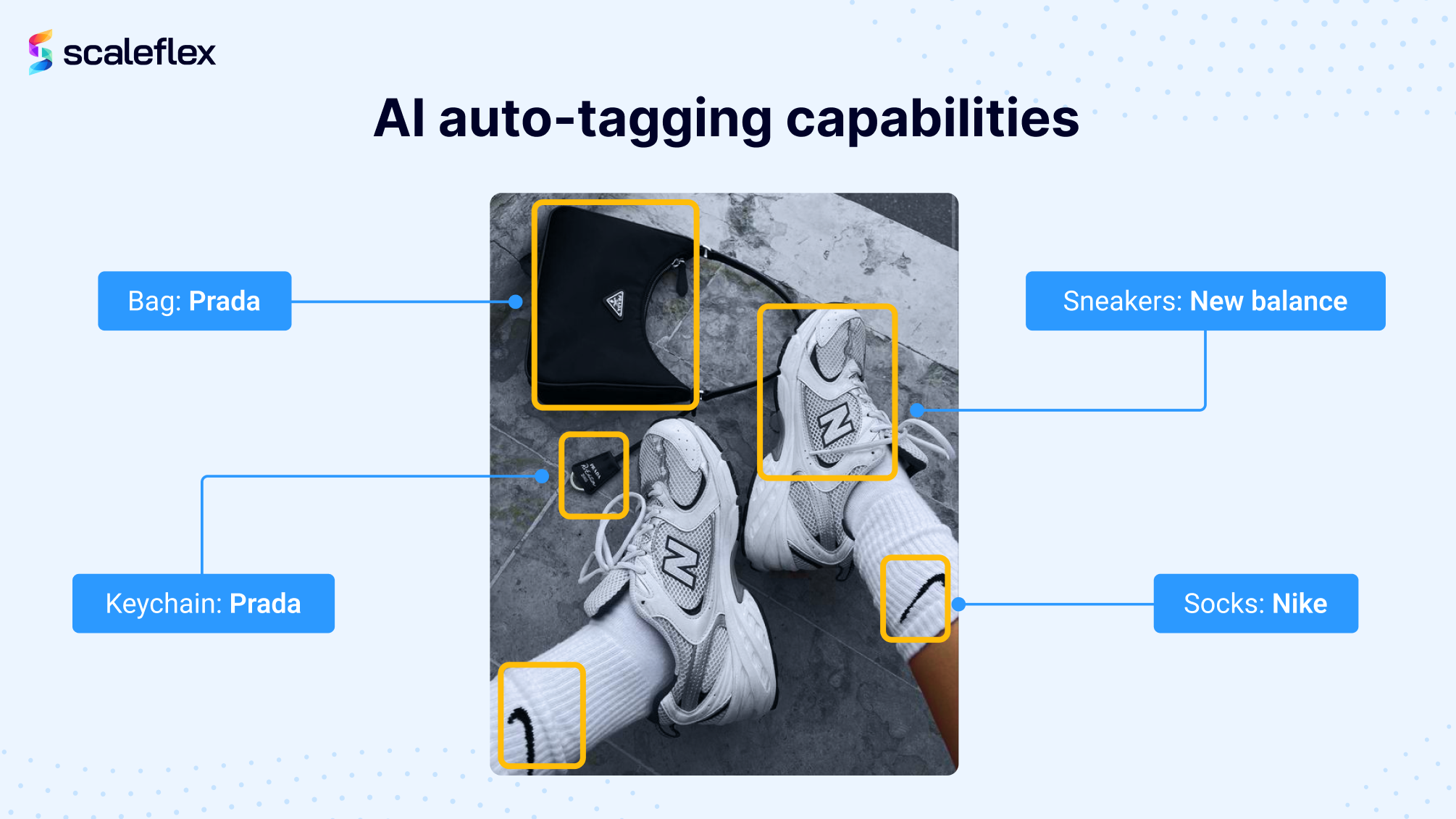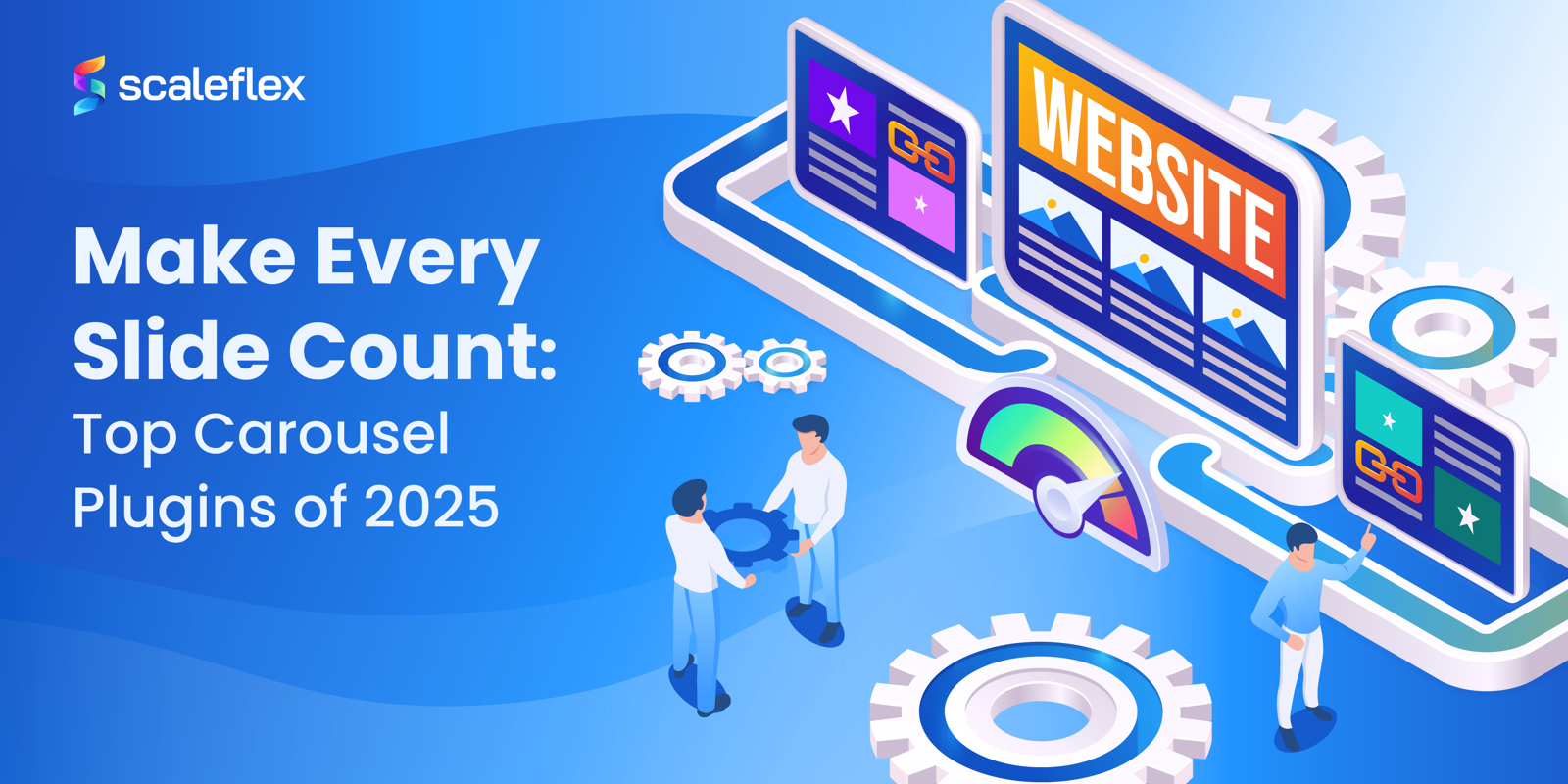6 Benefits of Using Visual AI in eCommerce
Online shoppers, retailers and eCommerce owners today are immersed in a rapidly evolving digital landscape, where staying ahead of the competition becomes harder by the day, and being merely present online just won’t cut it anymore. Strategic decisions and advanced technologies are necessary to stay ahead of the curve - and today we’re exploring together the cutting edge of eCommerce innovation.
In the landscape of e-commerce and online shopping, Artificial Intelligence has a transformative role, as it enhances user experience and operational efficiency. Using algorithms that are powered by AI, online shopping sites can provide personalized product recommendations, enhance product search and much more. There are also AI features specifically devoted to the optimization of all the behind-the-scenes areas of the sector, such as inventory management, stock, product development, accounting, etc.
Visual AI is a field of artificial intelligence that is capable of opening up a world of opportunities for online retailers, from enhanced search, to seamless virtual try-ons and improved inventory capabilities. Embracing this innovative solution is experiencing first hand a drive in customer engagement, an increase in conversation and a new age of eCommerce. Through this article, we’ll come to understand the six main transformative benefits of applying Visual AI for ecommerce strategy.
How to Use AI in eCommerce
Integrating Visual AI in ecommerce, an ever-evolving realm, can open up many possibilities for businesses. Through artificial intelligence there can be a transformation in the way businesses operate and relate to their customers. It’s a very advanced form of technology that has found applications in many aspects of online retail, and that offers innovative solutions to deal with the challenges at hand for the sector.
It’s possible to implement Visual AI in ecommerce in several ways:
- Enabling object recognition and smart tagging, to automatically identify items within visuals and populate them with relevant information to streamline inventory management.
- Powering personalized recommendations through Visual AI, analyzing consumer behavior to present tailored product suggestions.
- Facilitating visual search, which allows users to search for products via images instead of by typing, which improves accuracy as well as user experience.
- Activating virtual try-ons, which is when a customer can virtually try on clothing, accessories, cosmetics, stage how an object would look in their home, etc. before making a purchase, bolstering confidence and loyalty.
- Implementing content moderation that will automatically detect and remove offensive content from your comment section, inbox, social media, etc. to guarantee a safe environment for all your users.
Introducing Visual AI into your e-commerce operations can undeniably change the landscape of your business. Its applications have the capacity to improve customer satisfaction and elevate the overall shopping experience.
6 Benefits of Visual AI in eCommerce
Visual AI is a form of artificial intelligence that falls under the umbrella term of Computer Vision. What constitutes computer vision? Any and every kind of artificial intelligence system that is capable of “seeing” an image, processing its information, and making decisions or triggering automated actions based on the viewed object.
Stepping into the future of ecommerce, where the visual aspect is a crucial part of the journey for buyers, harnessing the power of Visual Artificial Intelligence will be paramount, as this game-changing technology is currently reshaping the online shopping status quo.
These innovative tools, when wielded correctly, can enhance user experience, optimize product discovery and elevate customer satisfaction. With capabilities ranging from augmented reality try-ons to intelligent research algorithms, the benefits of AI in ecommerce enrich online interactions and increase conversions. Through this insightful journey, we’ll discover the six main advantages Visual AI brings to the eCommerce table, and you’ll be ready to transform ordinary shopping experiences into extraordinary ones.
AI Image Classification
The properties of classification Visual AI holds have revolutionized ecommerce, as they automate the process of categorizing and tagging enormous amounts of visual information. The image classification technology uses deep learning algorithms to identify and classify products within images by using auto-tagging. This ensures a precise and error-free recognition of products. In the e-commerce sector, this means more streamlined inventory management, more efficient product labeling and improved search functionalities.

Visual AI automatically classifies products according to their visual attributes, which means businesses can enhance the accuracy of their search results and give consumers more relevant product recommendations. Classifying images with Visual AI reduces manual effort for businesses, leaving more time and resources for scaling operations. This implies an overall improvement of the customer experience, as it simplifies product discovery, but it also empowers businesses to make more data-driven decisions, to optimize their offerings and to implement the latest available technologies to drive higher sales and revenue.
Brand detection
Brand detection is a crucial functionality of AI in ecommerce, as it offers businesses an incredible advantage. Through advanced algorithms and machine learning training techniques, Artificial Intelligence can successfully identify brands in images or videos. This ensures a frictionless integration of branded content in the online shopping experience. Furthermore, brand detection is a feature that enables effective market analysis, enabling businesses to gauge the popularity of a specific brand, and optimize their inventory accordingly. Being able to have a nuanced understanding of customer preferences allows retailers to tailor their product offerings, enhancing consumer satisfaction and ultimately driving sales. For marketplaces, it allows seamless and automated classification of visuals by brand they carry. This saves countless hours of tiring manual work, flitting through images to classify them with the corresponding brand.
Lastly, this feature enables businesses to protect their intellectual property, as it can identify counterfeit products and maintain brand authenticity. Brand detection is, in a nutshell, a pivotal functionality of visual AI, as it shapes a more efficient and authentic e-commerce ecosystem.
Predictive Image Analytics
One of the most sophisticated facets of AI, predictive image analytics, can revolutionize e-commerce as it foresees consumer behaviors and preferences. Through the analysis of vast datasets of visual content, it’s able to anticipate trends, which can enable businesses to optimize their catalogs and tweak their marketing strategies. What’s more, predictive image analytics can identify patterns, such as popular colors, styles, product combinations, etc., providing priceless insight for product line decisions, inventory management and merchandising. It can enhance personalized shopping experiences, suggesting products according to the client’s visual interactions, which would in turn increase engagement, satisfaction and conversion rates. Since it can accurately predict consumer preferences, any business can streamline their supply chain, reduce excess inventory, minimize waste, and improve their operational efficiency all while increasing their profitability.
We can only add that, in essence, predictive image analytics can empower any e-commerce platform to stay ahead of the market demands, and offer clients directly what they want, increasing business growth as well as sustainability.
Background Changer
In the same line as the smart crop, the background changer is a vital functionality of Visual AI in ecommerce, as it radically transforms the visual presentation of products. This technology can enhance product images by seamlessly changing their backgrounds, to remove distractions, improve the overall aesthetic of the visual, or bring back focus to the sold item. Not only that, but it allows for consistency in the presentation, crafting a uniform look across the whole product catalog. It also allows businesses to adapt their product images to any platform or marketing material with minimum effort.

Changing the background of products for sale is a necessary part of curating an appealing and complete catalog, and automating this process can mean a more efficient management of product imagery, saving of time and resources, and more freedom to adjust to whatever suits each individual product best. Ultimately, it’s all about optimizing the visual appeal of products, and contributing to creating a compelling narrative and online shopping experience, making clients feel as if they would be physically stepping through the threshold of your beautiful store.
Smart Crop
Another fundamental functionality of Visual AI in ecommerce is the smart crop, which can drastically change the visual presentation of products online. Through an intelligent appraisal of images, the smart crop can identify key elements within the picture and automatically crop it for optimal display. Such precise cropping ensures that the products are showcased in the best possible light, enhancing their visual appeal and capturing the attention of the consumer. The smart crop has a pivotal role to play in standardizing product images, ensuring a cohesive and professional look for businesses throughout their platform. In addition, it can improve website loading times thanks to the reduction in image size, leading to a frictionless and responsive user experience. E-commerce businesses can save precious time and resources by automating this process. This allows them to focus on more critical aspects of their operations. The smart crop significantly enhances the visual impact of e-commerce platforms. It creates an appealing and inviting shopping environment for its clients.
Content Moderation
Content Moderation is one of the most crucial benefits of AI in ecommerce, and it has a crucial role to play when it comes to maintaining a safe and reputable online environment for e-commerce websites. Through advanced algorithms, Artificial Intelligence can automatically detect and filter any inappropriate or damaging content, be it text, images or videos. This is a proactive practice that ensures not only compliance with community guidelines and regulations, but also protects the business from any potential reputation harm. Modern content moderation algorithms can quickly identify and remove spam, offensive language, counterfeit products, and every other form of content that could violate platform policies. E-commerce businesses can ensure a more secure and trustworthy space by automating this process. It’s a technology that can improve online safety and save employees the effort of moderating, which can be tiresome and riddled with error, to allow them to focus on other areas to scale efficiently, all the while adhering to high quality content standards.
Return to the Table of ContentsKey Examples of AI benefits in eCommerce
In order to better frame the applications and benefits of Visual AI in ecommerce, we’re going to run through some real-life examples of ways in which this technology is currently being used by major retailers. These enterprises have not hesitated to leverage the transforming capabilities of Artificial Intelligence, and they will soon be reaping the benefits of it, if they aren’t already.

- ASOS, a well-known fashion retailer present throughout the world, already offers harnesses the benefits of AI in fashion by offering virtual try-on experiences to its clients, to enable customers to virtually try on their clothes and accessories before going through with their purchase. The technology is able to analyze facial features and body proportions, to then provide an accurate and immersive try-on experience, which boosts the client’s trust and noticeably reduces returns. Visual AI in fashion is paving the way for a completely new understanding of the way we shop fashion.
- Pinterest and Google have already integrated Visual AI to allow users to search for products by using images instead of keywords. From Google, a picture can be taken and the technology will analyze its visual elements, to then deliver relevant search results. This aids in product discovery that would otherwise be impossible, since searching “that cute top my coworker is wearing” doesn’t usually render the desired search results.
- Shopify and Amazon already take advantage of automated product tagging. They use Visual AI to automate this process. The technology recognizes and categorizes items, guaranteeing accurate product descriptions, and improving search relevance. This technology improves inventory management and streamlines the overall efficiency of online marketplaces.
- Ikea already uses Visual AI-powered augmented reality apps to enable customers to visualize furniture and decor objects in their own house, through the use of a smartphone or tablet. This technology superimposes virtual objects with a real backdrop using the camera of your mobile phone, enabling consumers to assess how the product fits the space. This leads to more confident and correct purchase decisions.
- Etsy and Instagram already use content moderation capabilities to automatically detect and remove inappropriate or offensive content from their universe and create safe environments for their users. The AI algorithms analyze visuals to ensure the shared content is compliant with community guidelines, to foster positive online communities.
Key Takeaways
To conclude, integrating Visual AI in ecommerce will lead to the reshaping of the industry, as it offers unparalleled opportunities to be leveraged by businesses and consumers alike. With a myriad of capabilities ranging from virtual try-on experiences to visual search capabilities, Visual AI is the motor driving innovation in the sector. The real-like impact and implementations of Visual AI cannot be overstated, as it can render online shopping more personalized, efficient, secure and simple for those who offer it.
As e-commerce is poised to continue evolving, Visual AI will serve as the cornerstone for all future endeavors, propelling the industry forward to the best interests of all parties involved. Scaleflex is partnering with a last-generation Visual AI solution for e-commerce, DeepSignals, that will provide our clients with the joint power of DAM and Artificial Intelligence to scale their operations and incite growth.
FAQ
How is AI changing eCommerce?
AI has revolutionized e-commerce as it offers beneficial solutions that lead to personalized experiences, efficient operations and better security. Ranging from predictive analytics to optimize inventory, to chatbots that provide instant customer service, AI is reshaping the way businesses interact with their clients. Processes are being streamlined thanks to real-time data analysis and automations, rendering e-commerce more intuitive, responsive, and consumer-centric.
How is AI used in online shopping?
AI plays a crucial role in online shopping, as it enhances user experiences and operational efficiency. Algorithms that are AI driven can power personalized product recommendations, improving sales and engagement. Visual AI, specifically, enables virtual try-ons and enhances product search, while AI chatbots provide instant support. AI can guarantee a more satisfying shopping journey online.
Return to the Table of Contents




